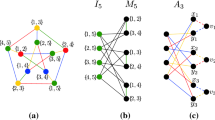Abstract
We investigate 4-chromatic Schrijver graphs from various points of view and color-critical edges in Schrijver graphs in general. In particular, we present the following results.
-
We give an elementary proof for the non-3-colorability of 4-chromatic Schrijver graphs thus providing such a proof also for 4-chromatic Kneser graphs.
-
We show that only certain types of edges of Schrijver graphs can be color-critical and prove that many of those are indeed color-critical, though in general not all of them are. In the 4-chromatic case these results give a complete characterization of the color-critical edges.
-
We show that a spanning subgraph of 4-chromatic Schrijver graphs quadrangulates the Klein bottle, while another spanning subgraph quadrangulates the projective plane. The latter is a special case of a result by Kaiser and Stehlík.
-
We show that (apart from two cases of small parameters) the subgraphs we present that quadrangulate the Klein bottle are edge-color-critical. The analogous result for the subgraphs quadrangulating the projective plane is an immediate consequence of earlier results by Gimbel and Thomassen and was already noted by Kaiser and Stehlík.
Our proof of non-3-colorability of 4-chromatic Schrijver graphs is based on a complete description of their structure that we present as well. This was already also given (in somewhat different terms) by Braun and even earlier in an unpublished manuscript by Li.
Similar content being viewed by others
References
Archdeacon, Dan, Hutchinson, Joan, Nakamoto, Atsuhiro, Negami, Seiya, Ota, Katsuhiro: Chromatic numbers of quadrangulations on closed surfaces. J. Graph Theory 37, 100–114 (2001)
Bárány, Imre: A short proof of Kneser's conjecture. J. Combin. Theory Ser. A 25, 325–326 (1978)
Braun, Benjamin: Symmetries of the stable Kneser graphs. Adv. in Appl. Math. 45, 12–14 (2010)
Benjamin Braun, Independence complexes of stable Kneser graphs, Electron. J. Combin., 18 (2011), Paper 118
Erdős, Pál, Hajnal, András: On chromatic graphs. Mat. Lapok 18, 1–4 (1967). (in Hungarian)
David Gale, Neighboring vertices on a convex polyhedron, in: Linear Inequalities and Related System, Annals of Mathematics Studies, no. 38, Princeton University Press (Princeton, N.J., 1956), pp. 255–263
Gallai, Tibor: Kritische Graphen I. MTA Mat. Kut. Int. Közl. 8, 165–192 (1963)
Gimbel, John, Thomassen, Carsten: Coloring graphs with fixed genus and girth. Trans. Amer. Math. Soc. 349, 4555–4564 (1997)
Richard, K.: Guy and Frank Harary, On the Möbius ladders. Canad. Math. Bull. 10, 493–496 (1967)
Kaiser, Tomáš, Stehlík, Matěj: Colouring quadrangulations of projective spaces. J. Combin. Theory Ser. B 113, 1–17 (2015)
Tomáš Kaiser and Matěj Stehlík, Schrijver graphs and projective quadrangulations, in: A Journey Through Discrete Mathematics: A Tribute to Jiří Matoušek, Martin Loebl, Jaroslav Nešetřil, Robin Thomas (eds.), Springer (2017), pp. 505–526
Tomáš Kaiser and Matěj Stehlík, Edge-critical subgraphs of Schrijver graphs, J. Combin. Theory Ser. B (in press), available online 14 February 2020
Kaiser, Tomáš, Stehlík, Matěj, Škrekovski, Riste: Replication in critical graphs and the persistence of monomial ideals. J. Combin. Theory Ser. A 123, 239–251 (2014)
Martin Kneser, Aufgabe 300, Jahresber. Deutsch., Math. Verein., 58 (1955), 27
Wei-Tian Li, Coloring reduced Kneser graphs, available at pdfs.semanticscholar .org/ea67/87df9b26c8841995c7cc6780affe906530be.pdf (2003)
Bart Litjens, Sven Polak, Bart Sevenster and Lluís Vena, On the chromatic number of a subgraph of the Kneser graph, Electronic Notes Discrete Math., 68, 227–232
Lovász, László: Kneser's conjecture, chromatic number, and homotopy. J. Combin. Theory Ser. A 25, 319–324 (1978)
Lovász, László: Self-dual polytopes and the chromatic number of distance graphs on the sphere. Acta Sci. Math. (Szeged) 45, 317–323 (1983)
Jiří Matoušek, Using the Borsuk–Ulam Theorem, Lectures on topological methods in combinatorics and geometry, Written in cooperation with A. Björner and G. M. Ziegler, Universitext, Springer-Verlag (Berlin, 2003)
Matoušek, Jiří: A combinatorial proof of Kneser's conjecture. Combinatorica 24, 163–170 (2004)
Mohar, Bojan, Seymour, Paul D.: Coloring locally bipartite graphs on surfaces. J. Combin. Theory Ser. B 84, 301–310 (2002)
Mohar, Bojan, Simonyi, Gábor, Tardos, Gábor: Local chromatic number of quadrangulations of surfaces. Combinatorica 33, 467–494 (2013)
Alexander Schrijver, Vertex-critical subgraphs of Kneser graphs, Nieuw Arch. Wisk. (3), 26 (1978), 454–461
Dale, A.: Youngs, 4-chromatic projective graphs. J. Graph Theory 21, 219–227 (1996)
Günter, M.: Ziegler, Generalized Kneser coloring theorems with combinatorial proofs. Invent. Math. 147, 671–691 (2002)
Acknowledgements
We thank Tomáš Kaiser and Matěj Stehlík for a useful conversation and in particular for drawing our attention to the paper [16]. We also thank an anonymous referee for a very thorough reading of our manuscript and for giving valuable suggestions.
Author information
Authors and Affiliations
Corresponding author
Additional information
Dedicated to Endre Szemerédi on the occasion of his 80th birthday
$This subtitle, on the one hand, refers to Definition 4 in Section 2, while, on the other hand, to the joke said by Endre Szemerédi in the beginning of his Abel lecture (which is available on youtube).
Research partially supported by the National Research, Development and Innovation Office (NKFIH) grants K-116769, K-120706, K-132696 and by the National Research, Development and Innovation Fund (TUDFO/51757/2019-ITM, Thematic Excellence Program).
Research partially supported by the Cryptography “Lendület” project of the Hungarian Academy of Sciences and by the National Research, Development and Innovation Office (NKFIH) grants K-116769, K-132696 and KKP-133864, by the ERC Synergy Grant “Dynasnet” No. 810115 and by the Ministry of Education and Science of the Russian Federation in the framework of MegaGrant No. 075-15-2019-1926.
Rights and permissions
About this article
Cite this article
Simonyi, G., Tardos, G. On 4-chromatic Schrijver graphs: their structure, non-3-colorability, and critical edges. Acta Math. Hungar. 161, 583–617 (2020). https://doi.org/10.1007/s10474-020-01080-z
Received:
Revised:
Accepted:
Published:
Issue Date:
DOI: https://doi.org/10.1007/s10474-020-01080-z




